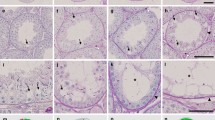Summary
Testes of human fetuses and newborns are controlled by serial sections, in order to demonstrate the form and arrangement of the tubular system. Unfortunately, this cannot be done but in a rugh schematic way because of the numerous branchings and coilings of the seminiferous tubules. Nevertheless, our investigations confirm that the tubules from also in human fetuses and newborns essentially arch-like structures with both ends returning to the rete testis as already stated by others, especially in animals. However, these arches show frequent branchings, composing therefore some kind of an arch-system or a network. Single, blindly ending tubules and blindly ending side-branches are hardly seen in human fetuses and newborns.
Zusammenfassung
An Hoden von menschlichen Feten und Neugeborenen wurde der Versuch unternommen, das Kanälchensystem auf Grund der Kontrolle von Serienschnitten räumlich darzustellen. Leider ist das wegen der zahlreichen Verzweigungen und Verschlingungen der Kanälchen nur grob schematisch möglich. Die Untersuchungen bestätigen aber, daß es sich auch beim Menschen entsprechend den vor allem bei Tieren erhobenen Befunden vorwiegend um Tubulusschlingen handelt, die an beiden Enden in das Rete testis münden. Die Schlingen sind jedoch vielfach verzweigt und bilden damit ganze Bogensysteme und netzartige Strukturen. Blind endende isolierte Kanälchen und blind endende Seitenästchen kommen bei menschlichen Feten und Neugeborenen dagegen kaum vor.
Similar content being viewed by others
Literatur
Bremer, J.L.: Morphology of the tubules of the human testis and epididymis. Amer. J. Anat. 11, 393–417 (1911).
Burlet, H.M. de: Zur Entwicklung und Morphologie des Säugerhodens. II. Marsupialier. Z. Anat. Entwickl.-Gesch. 61, 19–31 (1921).
Burlet, H.M. de, Ruiter, H.J. de: Zur Entwicklung und Morphologie des Säugerhodens. I. Der Hoden von Mus musculus. Anatomische Hefte 59, 325–382 (1921).
Clermont, Y., Huckins, C.: Microscopic anatomy of the sex cords and the seminiferous tubules in growing and adult male albino rats. Amer. J. Anat. 108, 79–97 (1961).
Curtis, G.M.: The morphology of the mammalian seminiferous tubule. Amer. J. Anat. 24, 339–394 (1918).
Grünwald, P.: Über Form und Verlauf der Keimstränge bei Embryonen der Säugetiere und des Menschen. I. Die Keimstränge des Hodens. Z. Anat. Entwickl.-Gesch. 103, 1–19 (1934).
Hirota, S.: The morphology of the seminiferous tubules. II. The seminiferous tubules of the monkey. Kyushu memoirs med. sciences 3, 129–136 (1952).
Huber, G.C., Curtis, G.M.: The morphology of the seminiferous tubules of mammalia. Anat. Rec. 7, 207–219 (1913).
Huber R., Weber, E., Hedinger, Chr.: Struktur intratubulärer Körperchen (sog. Ringtubuli) des kindlichen Hodens. Virchows Arch. Abt. A 344, 40–46 (1968).
Huber, R., Weber, E., Hedinger, Chr.: Zur mikroskopischen Anatomie der sog. hypoplastischen Zonen des normal deszendierten Hodens. Virchows Arch. Abt. A 344, 47–53 (1968).
Johnson, F. P.: Dissections of human seminiferous tubules. Anat. Rec. 59, 187–199 (1934).
Lauth, A.K.: Mémoire sur le testicule humain. Mém. de la société d'histoire naturelle de Strasbourg I (1930), zit. nach Stieda (1877) und Curtis (1918).
Liang, D.S.: Anatomical structure of the testicular tubule. Invest. Urol. 4, 285–287 (1966).
Mihalkovics, V. v.: Beiträge zur Anatomie und Histologie des Hodens. Arbeiten aus der physiologischen Anstalt zu Leipzig 8 (1873), Sitzungsberichte Kgl. Sachs. Gesell. der Wissenschaften 25,(1873), zit. nach Stieda (1877) und Curtis (1918).
Roosen-Runge, E.C.: The rete testis in the albino rat: its structure, development and morphological significance. Acta anat. (Basel) 45, 1–30 (1961).
Roosen-Runge, E.C., Lund, J.: Abnormal sex cord formation and an intratesticular adrenal cortical nodule in a human fetus. Anat. Rec. 173, 57–67 (1972).
Setchell, B.P.: Testicular blood supply, lymphatic drainage, and secretion of fluid. p. 101–239. In: The testis, vol. I, Development, anatomy and physiology, ed. by, Johnson, A.D., Gomes, W.R. and Vandemark, N.L.. New York-London: Academic Press 1970.
Stieda, L.: Über den Bau des Menschen-Hoden. Arch. mikr. Anat. 14 17–50 (1877).
Author information
Authors and Affiliations
Rights and permissions
About this article
Cite this article
Hedinger, C., Weber, E. Zur Struktur des Tubulussystemes in menschlichen Hoden. Z. Anat. Entwickl. Gesch. 139, 217–226 (1973). https://doi.org/10.1007/BF00523640
Received:
Issue Date:
DOI: https://doi.org/10.1007/BF00523640




